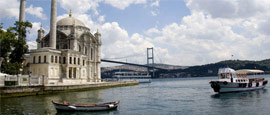Inaugurated by Byzantine Emperor Justinian in AD 537, the Hagia Sophia (Church of Divine Wisdom) is the crowning architectural masterpiece of the Byzantine Empire. Today, with its mammoth 56m (184ft) high dome, gold-daubed mosaics and Ottoman medallions, it remains one of the most inspiringly beautiful buildings in the world.
Things to see in Istanbul
Tourist offices
Hours vary
The tourist board goturkeytourism.com has six branches in Istanbul:
• Ataturk Airport Tourist Information (+90 212 6630798)
• Beyazit Tourist Information (+90 212 5224902)
• Karakoy Tourist Information (+90 212 2495776)
• Sirkeci Tourist Information (+90 212 5115888)
• Sultanahmet Tourist Information (+90 212 5181802)
• Taksim Hilton Tourist Information (+90 212 2330595)
This vast underground structure was built in AD 532 by Emperor Justinian, to be used as the reservoir for the Great Palace. With schools of carp flitting through the pools under the cathedral-like ceiling, supported by 336 mable columns – many recycled from pre-Christian temples – this is Istanbul’s most atmospheric sight.
With its cascade of opulent domes and slender, balconied minarets soaring towards the sky, this is Istanbul's most striking mosque. Built during the reign of Sultan Ahmet I, the mosque's blue İznik tiles (from which it gained its nickname), dominate the interior highlighted by shafts of light from over 250 windows.
Chora Museum, also known as the Church of the Holy Saviour in Chora, is covered with some of the oldest and finest surviving Byzantine mosaics and frescoes, a testament to the Byzantine Empire's artistic glory.
This bazaar is a city within the city and has been in business since 1461. Under the domed ceilings, the labyrinthine alleys contain over 4,000 shops, mosques, and hamams (Turkish baths), making the bazaar a fantastic place to wander around and shop.
Brought to life soon after Mehmet the Conqueror’s capture of Constantinople in 1453, the lavish salons, courts and pavilions here were the engine room of the Ottoman Empire right up to the 19th century. Don’t miss touring the labyrinthine haram and visiting the Treasury – home to the emerald-encrusted Topkapı dagger.
The artefacts here come from the Topkapı collections and include the stunning sarcophagi finds made in Sidon's Royal Necropolis (in Lebanon) by Ottoman archaeologist Osman Hamdi Bey. There's also a wealth of ancient sarcophagi, statuary and monuments from important pre-Islamic sites throughout Turkey, Syria and Iraq on display.
Located in a restored waterfront warehouse, the Istanbul Modern is Turkey's first museum of modern and contemporary art. It hosts a revolving program of world-class exhibitions throughout the year.
Commissioned by Süleyman the Magnificent in 1550, and designed by famed Ottoman architect Mimar Sinan, this mosque crowns one of Istanbul's seven hills and is an unmistakeable landmark. The interior, under the huge dome, is a lesson in symmetry and austere elegance while in the garden are the octagonal tombs of Sultan Süleyman and his wife Roxelana.
Originally the 16th century palace of Süleyman the Magnificent's Grand Vizier Ibrahim Pasha, this museum contains more than 40,000 artefacts from the 8th to the 19th century. Its carpet collection includes some of the finest rare textile pieces in the world, and its illuminated manuscript exhibits are also the standout highlights.
Commissioned by Emperor Valens in the 4th century CE, the Valens aqueduct (Bozdoğan Kemeri) was built to supply water to then Constantinople. Today, the aqueduct soars above the bustling Atatürk Boulevard with traffic passing through the structure's limestone arches makes for great pictures.
Do you have any Feedback about this page?
© 2025 Columbus Travel Media Ltd. All rights reserved. No part of this site may be reproduced without our written permission, click here for information on Columbus Content Solutions.








 You know where
You know where